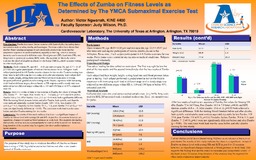
ATTENTION: The works hosted here are being migrated to a new repository that will consolidate resources, improve discoverability, and better show UTA's research impact on the global community. We will update authors as the migration progresses. Please see MavMatrix for more information.
Show simple item record
| dc.contributor.author | Ngwanah, Victor | |
| dc.date.accessioned | 2017-04-13T20:26:29Z | |
| dc.date.available | 2017-04-13T20:26:29Z | |
| dc.date.issued | 2015 | |
| dc.identifier.uri | http://hdl.handle.net/10106/26608 | |
| dc.description | KINE 4400 | en_us |
| dc.description.abstract | Introduction: Zumba is a dance fitness exercise with Latin rhythm including dance movements such as salsa, rumba, and merengue. Previous studies have shown that aerobic dance training programs do not necessarily produce the same aerobic adaptation responses in cardiorespiratory capacity as running, however exercise intensity can be assessed in different ways: blood pressure (BP), heart rate (HR), and Borg’s rate of perceived exertion (RPE) scale. The purpose of this study was to evaluate the effect of Zumba on fitness levels during YMCA graded exercises testing in a two week period
Methods: Three women (W; age 40.0 + 4.16 yrs) and two men (M; age 32.5 + 10.67 yrs) who are regular participants of various Zumba classes in the Arlington. Each subject participated in 6-8 Zumba exercise classes for two weeks. Exercise testing was done prior to and following the two weeks of Zumba participation. Each subject had their weight, height, resting heart rate and blood pressure taken prior to testing. Subjects performed graded exercise testing on the bicycle ergometer with increasing work load at different stages, chosen based on HR response until a steady state was achieved in two different stages within HR of 110 and 150 bpm or at 85% estimated max HR.
Results: After two weeks of eight to ten sessions of Zumba, the values of resting HR (Pre Zumba 72 ±10.5 bpm; Post Zumba: 64.9 ±7.6 bpm), p = 0.01 and RPE (before Zumba 14.8 ±1.6; After Zumba: 13.6 ±1.1), p = 0.03 were both significantly different. With the resting blood pressure before and after Zumba, both systolic and diastolic were analyzed separately (systolic before Zumba: 129 ±15.6; post Zumba: 126 ±10.3), p = 0.4, Diastolic: before Zumba: 78.4 ±11.6, post Zumba: 74.2 ±8.9), p = 0.1 were not significantly different (p > 0.05). The maximum work load was the same before and after Zumba training for two weeks
Conclusion: The results of this study indicate that there is a significant impact of Zumba on fitness level with resting HR and RPE in just 8 to 10 sessions however, no significant changes occurred in blood pressure or work load. This supports the finding that aerobic exercise increases parasympathetic control of the heart at rest. However, long duration of the exercise may be required for other cardiorespiratory improvements. | en_US |
| dc.description.sponsorship | Faculty Sponsor, Judy Wilson | en_US |
| dc.language.iso | en_US | en_US |
| dc.subject | Blood pressure | en_US |
| dc.subject | Cardiorespiratory improvements | en_US |
| dc.subject | Borg’s rate of perceived exertion (RPE) scale | en_US |
| dc.title | The Effects of Zumba on Fitness Levels as Determined by The YMCA Submaximal Exercise Test | en_US |
| dc.type | Presentation | en_US |
| dc.publisher.department | Department of Kinesiology, The University of Texas at Arlington | en_us |
| dc.publisher.department | Cardiovascular Laboratory, The University of Texas at Arlington | en_us |
| dc.publisher.department | Exercise Science Research Laboratories, The University of Texas at Arlington | en_us |
Files in this item
- Name:
- Ngwanah.pdf
- Size:
- 565.7Kb
- Format:
- PDF
- Description:
- PDF
This item appears in the following Collection(s)
Show simple item record


